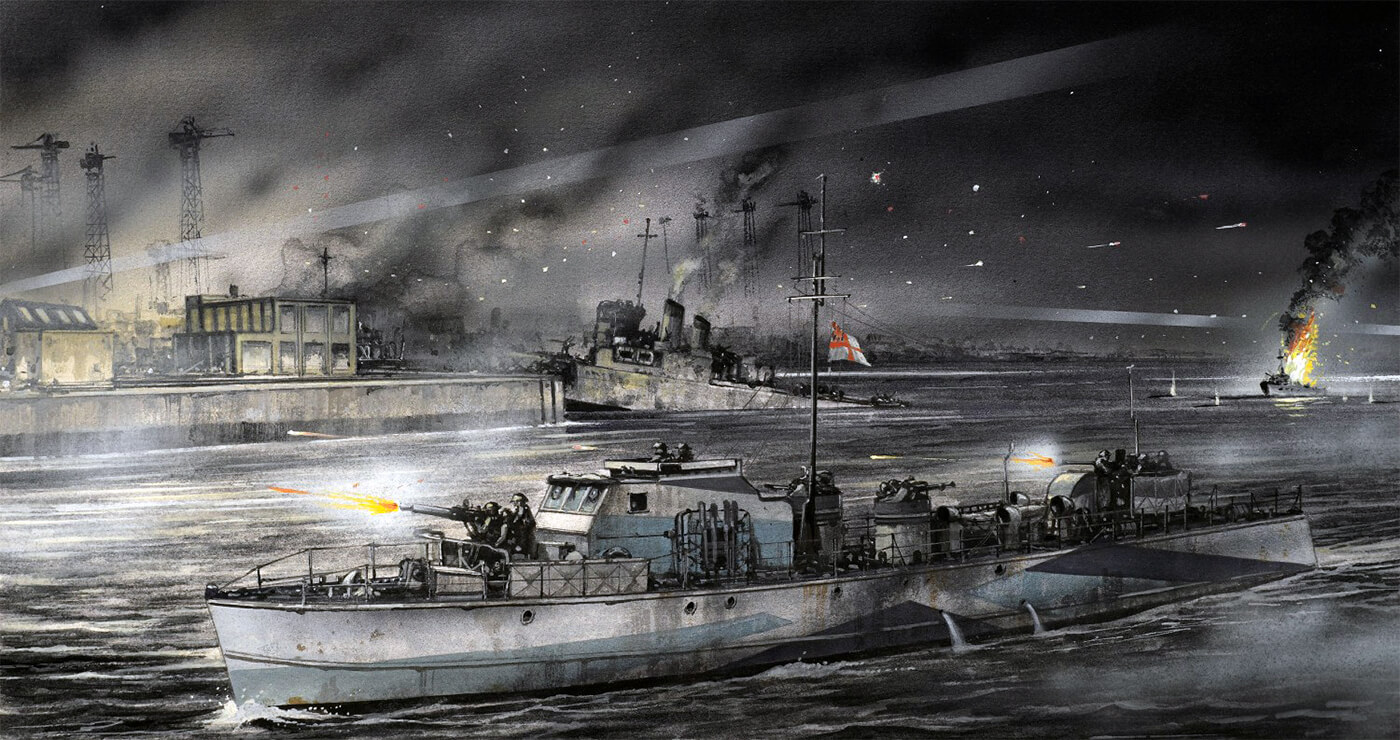| Special Forces Operations in August 1942 |
| August 1942 – May 1943 |
| North African Deployment, Decima Flottiglia MAS |
| Xa Flottiglia MAS |
| In 1942, naval and land-based special operations in the Mediterranean intensify. The British Eighth Army and Axis forces compete for control, both prioritising logistics and counter-offensives. The Italian Xª Flottiglia MAS adapts its tactics, deploying explosive boats along the North African coast. These are transported covertly aboard disguised trawlers such as Sogliola and Constanza. Following the Axis offensive in Libya and the capture of Tobruk in June 1942, Italian naval forces establishes a mobile assault unit, Autocolonna Giobbe, in Egypt. Using small torpedo boats, they launch surprise attacks on British naval units near El Alamein, notably damaging H.M.S. Eridge in August 1942. However, increasing British air superiority force them to retreat. By late 1942, as the Axis front collapses at El Alamein, Autocolonna Giobbe withdraw through Libya to Tunisia, where it merge with other units. Despite logistical challenges, it continues operations until May 1943, when the Axis evacuated North Africa. With the Allied invasion of Sicily in July 1943, plans for further Italian naval assault operations are disrupted. Many boats are lost or destroyed, and the Sicilian front’s collapse ended the Xª Flottiglia MAS’s Mediterranean land-based operations. |
| August 5th, 1942 – August 8th, 1942 |
| Operazione Cefalo 2 |
| Xa Flottiglia MAS |
| The fishing trawler Cefalo conducts, repeating its previous mission in the waters south of the Balearic Islands. As in July, the trawler, manned by a militarised civilian crew, carries two MTSM’s, concealed under fishing equipment, with the objective of ambushing Allied aircraft carriers operating in the area. Despite maintaining its cover as a fishing vessel and patrolling the designated waters, no enemy targets are sighted. The mission ends without engagement, and the Cefalo returns to base without deploying its assault craft, mirroring the outcome of its first operation. |
| August 7th, 1942 – August 8th, 1942 |
| Operation Watchtower, Capture of the Tulagi and Gavutu–Tanambogo Islands |
| 1st Raider Battalion, U.S. Marine 1st Parachute Battalion |
| 1st Raider Battalion, U.S. Marine 1st Parachute Battalion and support troops from the U.S. Marines. Initially, the plan focuses on Tulagi and the Santa Cruz Islands, but the discovery of Japanese airfield construction on Guadalcanal leads to its inclusion, replacing the Santa Cruz operation. Japanese signals intelligence detects the Allied movements but misinterprets their destination. The Watchtower force, including 75 warships and transports, assembles near Fiji on July 26th, 1942, and departs for Guadalcanal on July 31st, 1942. U.S. Vice Admiral Frank Fletcher commands the expeditionary force, with Rear Admiral Richmond K. Turner leading the amphibious forces and Vandegrift commanding the 16,000-strong landing forces, mainly U.S. Marines. On August 7th, 1942, poor weather allows the Allied force to approach undetected. The landing force divides, with one group targeting Guadalcanal and the other Tulagi, Florida, and Gavutu-Tanambogo. Aircraft from the U.S.S. Wasp bomb Japanese installations and destroy seaplanes. U.S. Marines land on Florida Island at 07:40 and on Tulagi at 08:00, facing minimal initial resistance. Japanese defenders on Tulagi, Gavutu, and Tanambogo prepare for a last stand. The Marines secure positions on Tulagi and advance against increasing resistance. Overnight, the Japanese launch five attacks, but the Marines hold firm. On August 8th, 1942, reinforcements help secure Tulagi. Marines assault Gavutu at noon, facing heavy resistance but eventually clearing Japanese positions. Tanambogo is attacked later, with Marines overcoming strong defenses and destroying caves. By August 9th, 1942, resistance on Tanambogo ceases. The battles result in significant casualties: 307 Japanese and 45 U.S. troops die on Tulagi, while 476 Japanese and 70 U.S. personnel die on Gavutu-Tanambogo. Several Japanese and Korean laborers are captured. |
| August 10th, 1942 |
| Operazione SL 1 |
| Xa Flottiglia MAS |
| Raid on Haifa, Palestine. Submarine Sciré with three Siluro a Lenta Corsa’s aboard. On August 10th, 1942, the submarine Scirè, already renowned for previous significant actions, was tasked with covertly transporting 11 men from the Gamma group to the port of Haifa, then under British mandate in Palestine. The operational order stipulated that the Scirè would release the Gamma operators 2 kilometres from Haifa’s port and wait for their return until 03:00 before heading back to Leros. Departing from Leros on August 6th, 1942, the submarine maintained radio contact with the Naval Command in Rhodes, receiving updates from aerial reconnaissance regarding the presence of ships in Haifa’s port. Unfortunately, on August 10th, 1942, the Scirè was detected by British forces while attempting to reach the release point for the operatives. It came under intense attack from the British minesweeper H.M.S. Islay, supported by other naval units with depth charges. The Scirè surfaces briefly before sinking during which time she is shelled by No. 300 Coast Battery, leading to its sinking. There are no survivors; the entire crew and the operatives on board lost their lives during the mission. A few days later, the sea returned the bodies of operators Egil Chersi and Eugenio Dal Ben, who were honorably buried by British authorities in the Haifa cemetery. |
| August 17th, 1942 – August 18th, 1942 |
| Raid on Makin Island |
| 2nd Raider Battalion |
| The raid on Makin Island aims to divert Japanese attention from Guadalcanal, disrupt reinforcements, gather intelligence, and destroy enemy facilities. Makin Island, particularly Butaritari, offers strategic advantages due to its dense vegetation and narrow land strip. The raiding force, Task Unit 7.15.3, consists of 13 officers and 208 enlisted men from Company A and B, led by Lieutenant Merwyn C. Plumley and Captain Ralph H. Coyte of the 2nd Raider Battalion. They depart from Pearl Harbor aboard the U.S.S. Nautilus and U.S.S. Argonaut, reaching Makin on August 16th, 1942. Early on August 17th, 1942, the submarines arrive at the debarkation point. Difficulties during unloading lead to a change in plan, with all boats directed to a single landing site, Beach Z. Despite some boats landing off-course, the troops manage to regroup and begin the operation unopposed until a rifle discharge alerts the Japanese. Company A secures Government Wharf and House by 06:00 but encounters heavy resistance along the lagoon road. Reinforced by Company B, they overcome Japanese defenses. The arrival of Japanese ships in the lagoon is neutralized by the submarines’ deck guns. The battle intensifies with aerial attacks. Carlson, the commanding officer, attempts to lure snipers but faces continued resistance. Despite a final intense bombing at 16:30, the raiders can’t capture prisoners or destroy key facilities. Withdrawing at 19:30, they aim to preserve their forces. 19 Raider Marines were killed in action during the raid. |
| August 19th, 1942 |
| Operation Jubilee |
| Commandos, U.S. Army Rangers |
| Canadian 2nd Infantry Division, 14th Army Tank Regiment (The Calgary Regiment (Tank)) and British No. 3 Commando, No. 4 Commando (50 U.S. Army Rangers), No. 10 Commando, No. 30 Commando, No. 40 Commando. Their mission is to capture and occupy for a brief period the port town of Dieppe, to test the feasibility of a landing and to gather intelligence. Before leaving, the invasion force, must destroy the German coastal defences, port structures and important buildings. |
| August 29th, 1942 |
| North African Deployment, Decima Flottiglia MAS |
| Xa Flottiglia MAS |
| Raid on El Daba, Egypt. The destroyer H.M.S. Eridge was torpedoed at close range by an Motoscafo da Turismo Silurante Modificato. The H.M.S. Eridge lost six crewmembers and was towed to Alexandria. There the ship was declared a constructive total loss. |

